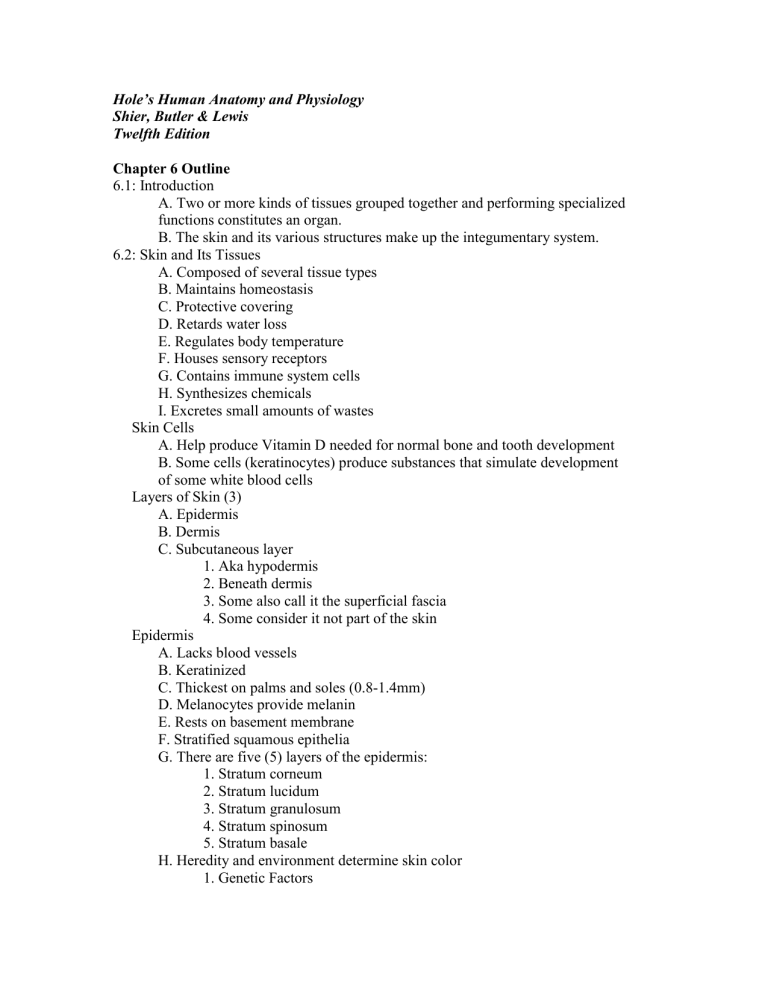AP1 CH6 Outline2018
advertisement

Hole’s Human Anatomy and Physiology Shier, Butler & Lewis Twelfth Edition Chapter 6 Outline 6.1: Introduction A. Two or more kinds of tissues grouped together and performing specialized functions constitutes an organ. B. The skin and its various structures make up the integumentary system. 6.2: Skin and Its Tissues A. Composed of several tissue types B. Maintains homeostasis C. Protective covering D. Retards water loss E. Regulates body temperature F. Houses sensory receptors G. Contains immune system cells H. Synthesizes chemicals I. Excretes small amounts of wastes Skin Cells A. Help produce Vitamin D needed for normal bone and tooth development B. Some cells (keratinocytes) produce substances that simulate development of some white blood cells Layers of Skin (3) A. Epidermis B. Dermis C. Subcutaneous layer 1. Aka hypodermis 2. Beneath dermis 3. Some also call it the superficial fascia 4. Some consider it not part of the skin Epidermis A. Lacks blood vessels B. Keratinized C. Thickest on palms and soles (0.8-1.4mm) D. Melanocytes provide melanin E. Rests on basement membrane F. Stratified squamous epithelia G. There are five (5) layers of the epidermis: 1. Stratum corneum 2. Stratum lucidum 3. Stratum granulosum 4. Stratum spinosum 5. Stratum basale H. Heredity and environment determine skin color 1. Genetic Factors a. Varying amounts of melanin b. Varying size of melanin granules c. Albinos lack melanin 2. Environmental Factors a. Sunlight b. UV light from sunlamps c. X-rays d. Darkens melanin 3. Physiological Factors a. Dilation of dermal blood vessels b. Constriction of dermal blood vessels c. Accumulation of carotene d. Jaundice 6.1 Clinical Application: Tanning and Skin Cancer Dermis A. On average 1.0-2.0mm thick B. Contains dermal papillae C. Binds epidermis to underlying tissues D. Irregular dense connective tissue E. Muscle cells F. Nerve cell processes G. Specialized sensory receptors H. Blood vessels I. Hair follicles J. Glands K. There are actually two (2) layers to the dermis: 1. Papillary layer a. Thin b. Superficial c. Dermal papillae here 2. Reticular layer a. 80% of dermis b. Cleavage, tension or Langer’s lines are here Subcutaneous Layer A. Aka hypodermis B. Loose connective tissue and … C. Adipose tissue is present D. Insulates E. Major blood vessels present 6.3: Accessory Structures of the Skin A. Accessory structures of the skin originate from the epidermis and include: 1. Hair follicles 2. Nails 3. Skin glands Hair Follicles A. Epidermal cells B. Tube-like depression C. Extends into dermis D. Three (3) parts: 1. Hair root 2. Hair shaft 3. Hair papilla E. Dead epidermal cells F. Melanin G. Arrector pili muscle Nails A. Protective coverings B. Three (3) parts: 1. Nail plate 2. Nail bed 3. Lunula 6.2 Clinical Application: Hair Loss Sebaceous Glands A. Usually associated with hair follicles B. Holocrine glands C. Secrete sebum (oil) D. Absent on palms and soles Sweat Glands A. Aka sudoriferous glands B. Widespread in skin C. Originates in deeper dermis or hypodermis D. Eccrine glands E. Apocrine glands F. Ceruminous glands G. Mammary glands 6.3 Clinical Application: Acne 6.4: Regulation of Body Temperature A. Regulation of body temperature is vitally important because even slight shifts can disrupt metabolic reactions. Heat Production and Loss A. Heat is a product of cellular metabolism 1. The most active body cells are the heat producers and include: a. Skeletal muscle b. Cardiac muscle c. Cells of certain glands such as the liver B. The primary means of heat loss is radiation 1. Also there is conduction, convection and evaporation Problems in Temperature Regulation A. Hyperthermia – abnormally high body temperature B. Hypothermia – abnormally low body temperature 6.4 Clinical Application: Elevated Body Temperature 6.5: Healing of Wounds and Burns A. Inflammation is a normal response to injury or stress. B. Blood vessels in affected tissues dilate and become more permeable, allowing fluids to leak into the damaged tissues. C. Inflamed skin may become: 1. Reddened 2. Swollen 3. Warm 4. Painful Healing of Cuts Types of Burns A. First degree burn – superficial, partial-thickness B. Second degree burn – deep, partial-thickness C. Third degree burn – full-thickness 1. Autograft 2. Homograft 3. Various skin substitutes Rule of Nines for Adults 6.6: Lifespan Changes A. Skin becomes scaly B. Age spots appear C. Epidermis thins D. Dermis becomes reduced E. Loss of fat F. Wrinkling G. Sagging H. Sebaceous glands secrete less oil I. Melanin production slows J. Hair thins K. Number of hair follicles decreases L. Nail growth becomes impaired M. Sensory receptors decline N. Body temperature unable to be controlled O. Diminished ability to activate Vitamin D Outcomes to be Assessed 6.1: Introduction Define organ, and name the large organ of the integumentary system. 6.2: Skin and Its Tissues List the general functions of the skin. Describe the structure of the layers of skin. Summarize the factors that determine skin color. 6.3: Accessory Structures of the Skin Describe the accessory structures associated with the skin. Explain the functions of each accessory structure of the skin. 6.4: Regulation of Body Temperature Explain how the skin helps regulate body temperature. 6.5: Healing of Wounds and Burns Describe the events that are part of wound healing. Distinguish among the types of burns, including a description of healing with each type. 6.6: Lifespan Changes Summarize lifespan changes in the integumentary system.








